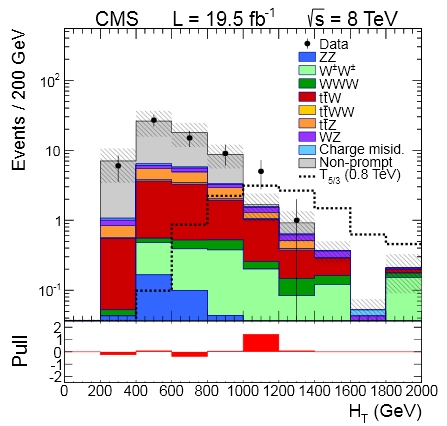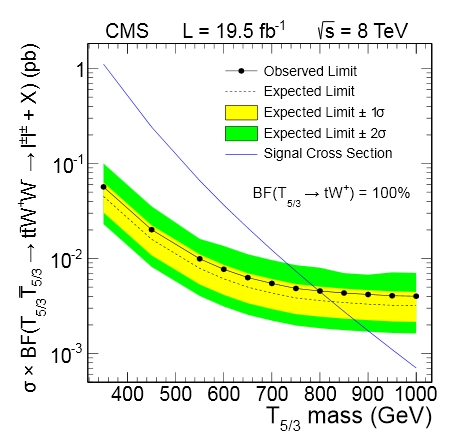Ever since quarks were understood to be the constituents of hadronic matter - protons, neutrons, and every other composite object held together by the strong force - the search for new such elementary objects has enthralled particle physicists. Experimentalists have tried to produce heavier copies of the six known quarks (respectively called up, down, charm, strange, top, and bottom) using higher and higher collision energies; theorists have in the meantime tried to calculate how new quarks could fit in the existing theoretical framework, or in extensions of it, and speculated on the possible positive effects of including in extended models new replicas of the six known quarks.
In a paper appeared today in the Cornell Arxiv, the CMS collaboration has released information on a new search for a partner of the top quark. This is not exactly like a fourth-generation quark like all others; rather, it would be an object with different characteristics. Most notably, it would have an electric charge of +5/3, that is one full unit of electric charge more than the top. Such an exotic object might provide a possible solution to a nagging problem of the current theoretical framework, the so-called "hierarchy problem" which I discussed in detail in other posts - ok, ok, I will briefly explain what it is here, too.
The hierarchy problem is the observation that the mass of the higgs boson results from the addition and subtraction of very large contributions due to quantum corrections involving "loops" of known standard model particles. The best analogy to explain why we are surprised that the Higgs mass is small comes from a reader of this blog, and I like to quote it below:
"Suppose that sum of the profits and losses of ten companies turn out to average out to be $10. If you only know this fact, and that a priori profits and losses in any given year appear to be more or less equally likely in the highly competitive market where these companies operate, what kinds of gross revenues to you expect the average company to have? Knowing only these facts, you might expect for a string of lemonade stands in a busy residential neighborhood. But you would be shocked if you learned that the companies had gross revenues that averaged tens of billions of dollars a year each for the average profit to net out to $10 simply as a random average, even if profits and losses were equally likely. You would suspect that someone had carefully combed through tens of thousands of corporate reports to come up with a combination that was so equally balanced on purpose.While the solution that most theorists still favor is the one involving the introduction of supersymmetric partners of all standard models fermions and bosons, in a way that perfectly cancels out one by one all the large quantum contributions to the Higgs mass, there are alternatives which are, let's say, more economical. The idea of top quark partners is one of them.
Physics, similarly, suspect based upon the unnaturalness of the near perfect balancing of the loop corrections in the absence of some unknown non-random principle that causes them to nearly balance out, when compared to the scale of the components, that the loop corrections probably actually balance due to some hidden structure that we haven't yet discovered."
So CMS performed an experimental search for heavy, charge +5/3 particles that could be produced in pairs in the proton-proton collisions of the LHC, and both decay to a top quark and a equal-sign W boson. The signature thus includes a pair of top quarks and two W bosons: it is a rather busy one, since top quarks also decay to a bottom quark jet and a W boson. One thus expects four W bosons and two b-quark jets in the event.
The most economical, clean way to look for similar events is to select the case when two of the W bosons of equal electric charge (the two W+, or the two W-) decay yielding electrons or muons. One in that case is looking for events with two high-energy leptons of the same charge - a signature that standard model processes have quite a hard time to mimic. Besides those two same-sign leptons the event of course will also feature significant missing transverse energy and a number of hadronic jets.
Among backgrounds that need to be considered there is top pair production, when one final state lepton has its charge misunderstood for instrumental reasons or is coming from a b-quark decay rather than from W decay (this allows two leptons to have the same charge, when e.g. a W+ from the top quark decays to a positive-charge lepton and the anti-bottom quark produced by the anti-top quark decays to anti-charm plus a second positive-charge lepton); and a series of low-yield standard model multi-object production processes including ttW, ttZ, WWW, etcetera.
The kinematical selection includes the requirement of two same-charge leptons, a Z-boson veto, and the presence of at least seven "constituents" - counting jets and leptons as final state objects. A top quark decay may yield three such objects, and a W may yield two, so a ttWW state can yield up to 10 objects; asking for the presence of at least seven of them makes up for good efficiency and high background rejection. Finally, the variable which is examined to study the contamination of the 5/3 exotic quark is the HT, which is the sum of transverse energies of all reconstructed objects. The distribution of the HT is shown below, with known backgrounds in colour and the signal contribution as a dashed histogram overlaid. The black points are the experimental data coming from the 20/fb of 8 TeV collisions collected by CMS in the 2012 run.

Despite one high bin, due to a statistical fluctuation, there is no evidence for a signal contribution, so by considering different masses for the signal and the respective detection efficiency, the good agreement with the data to backgrounds alone allows to extract upper limits on the signal cross section. The latter is then converted to a lower limit on the exotic quark mass by comparing the cross section limit to the theoretical prediction, as shown in the graph below.

Here you can see that as the top partner mass increases, theory predicts smaller and smaller yields (thin blue curve). The experimental limit (string of black points) thus "kills" the low mass hypotheses - since they would have yielded a too large number of signal candidates, which has not been observed. The result is a lower limit of 800 GeV on the exotic top parner mass. Bear in mind, though, that this only applies to such particles if they decay 100% of the time into the tW final state; as you loosen up that criterion, the cross section limit also loosens (the limit curve goes up) so the mass limit becomes weaker (the intercept is found at masses below 800 GeV).
In conclusion, CMS has set a limit on exotic charge-5/3 top partners at 800 GeV, while the previous lower mass limit was at 365 GeV. This is a significant extension; however the models that predict such particles hypothesize masses up to 1.5 TeV. That will be a business for the LHC run 2, when CMS will collect data at 13 and then 14 TeV, and lots of it. Who knows, these fancy objects might show up there!
For the preprint look here.





Comments